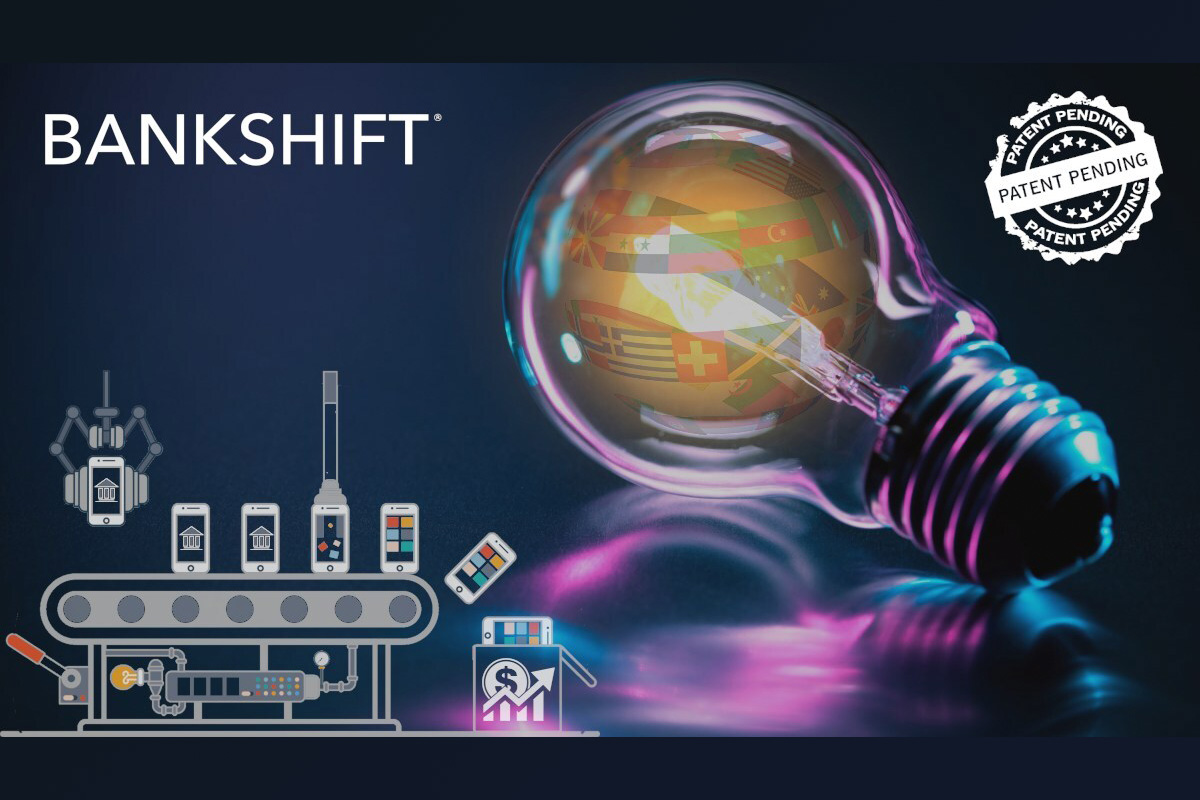Fintech
BankShift Files International Patents to Revolutionize Embedded Banking Technology

ShiftCents, Inc., also known as BankShift, an emerging leader in embedded banking innovation, is proud to announce the submission of an international patent application for its revolutionary Brand On Banking technology. This milestone builds on the company’s success in securing non-provisional patent-pending status in the United States in early 2024, further underscoring BankShift’s commitment to protecting its intellectual property on a global scale while addressing the growing demand for embedded banking solutions that enable financial institutions and brands to deepen consumer engagement and foster loyalty.
BankShift empowers financial institutions to white-label their consumer banking products for brands, driving new engagement, value, and loyalty. By leveraging this proprietary solution, financial institutions can distribute banking products within traditionally non-financial experiences, delivering modernized customer experiences while maintaining regulatory compliance.
The market for embedded banking is primed for transformation, representing a $1.5 trillion global fintech opportunity. Traditional financial institutions and brands are actively seeking solutions to seamlessly integrate banking services into their consumer ecosystems, creating deeper relationships and actionable data insights. BankShift is uniquely positioned to meet this need, offering a full-stack, turnkey solution that stands apart from conventional banking-as-a-service providers by enabling direct customer experience management while ensuring regulatory fidelity.
“We’re excited to take this next step in securing our innovation internationally,” said Rob Thacher, Founder and CEO of BankShift. “Our technology, already patent-pending in the United States, positions financial institutions and brands to build stronger, more personalized consumer relationships while driving significant growth together. This international patent filing reinforces our mission to modernize embedded banking and protect the value we bring to our partners.”
BankShift’s Market Impact
- Problem: Brands seek to stand out and deepen their connection with consumers by building financial relationships that provide valuable data and insights, ultimately driving sales and retention. However, financial institutions often lack the modern infrastructure and expertise needed to enable embedded banking.
- Solution: BankShift is a turnkey solution for financial institutions to distribute banking products within traditionally non-financial experiences, maintaining regulatory fidelity while enabling third parties to grow their business and enhance customer experiences to foster loyalty.
BankShift invites financial institutions and popular brands to explore the possibilities unlocked by its embedded banking technology. Consult with them today to learn more about how BankShift can revolutionize your embedded banking offering and elevate your brand presence.
The post BankShift Files International Patents to Revolutionize Embedded Banking Technology appeared first on News, Events, Advertising Options.
Fintech
Fintech Pulse: Your Daily Industry Brief – April 24, 2025 (Revolut, Citigroup, BNP Paribas, Coinbase, Omnea, HKIAS)

In today’s rapidly evolving financial landscape, staying abreast of the latest developments in fintech is not just an advantage—it’s imperative. From blockbuster profit milestones to seismic collapses, and from talent wars in U.S. banking hubs to pioneering academic–industry collaborations in Hong Kong, April 24, 2025, offers a whirlwind of insights. In this edition of Fintech Pulse, we dissect five pivotal stories, offer opinion-driven analysis, and explore the broader industry implications.
1. Revolut’s Profit Bonanza: Mainstreaming the Super-App
What happened:
British fintech unicorn Revolut announced a record pre-tax profit of £1.1 billion ($1.46 billion) for the year ending December 31, 2024—up 149% year-on-year—on revenues of £3.1 billion, a 72% increase over 2023.
Why it matters:
Revolut’s profit surge marks its transformation from a niche currency-exchange app into a full-blown digital bank aiming for global scale. Having secured a UK banking license after a protracted three-year approval process, it now seeks to expand into lending products—credit cards, personal loans, and mortgages—to capture a larger share of customers’ financial lives.
Analysis & Commentary:
In my view, Revolut’s results underscore a broader trend: “super-apps” consolidating diverse financial services under one roof. Crypto trading and wealth management now account for a significant slice of profits, but true differentiation will come from how seamlessly Revolut integrates lending. As traditional banks shutter branches, fintech challengers can accelerate customer acquisition—but must manage credit risk carefully to avoid overextension. I believe regulators will keep a close watch on how Revolut scales its loan book, especially given its 86% year-on-year increase in customer lending balances to £979 million.
Source: CNBC
2. Stenn’s Implosion: A Cautionary Tale in Trade Finance
What happened:
Trade-finance fintech Stenn Technologies, once touted as a $1 billion rising star, collapsed into administration last December, leading to the loss of most of its 200 jobs. Investigations revealed that major banks—including Citigroup and BNP Paribas—backed deals they barely vetted, missing warning signs as weekly deal summaries ballooned to nearly $1 billion in size.
Why it matters:
Stenn’s collapse highlights persistent due-diligence gaps in trade finance. As fintechs promise speed and efficiency, established banks must not sacrifice risk controls for deal flow. The fallout eroded confidence and may prompt stricter counterparty assessments industry-wide.
Analysis & Commentary:
I argue that this episode is symptomatic of a “too eager to lend” mindset. In an environment of slackening yields, large banks pursued yield-rich fintech credit lines, only to face unexpected defaults. Going forward, I expect banks to re-evaluate their fintech partnerships, incorporating more robust real-time monitoring and third-party risk assessments. Stenn’s demise should catalyze the adoption of blockchain-based trade-finance platforms that embed transparency and immutable audit trails. Until then, caution remains the watchword.
Source: Bloomberg
3. Coinbase’s Southern Pivot: The Talent Play
What happened:
Coinbase, the largest U.S. cryptocurrency exchange, is targeting Charlotte, North Carolina, for a major talent investment—adding over 130 employees to its compliance and customer-support teams and potentially scaling to 1,000 new U.S. hires this year.
Why it matters:
Charlotte has long been a banking powerhouse, but its rising pool of tech talent makes it an attractive fintech hub. Coinbase’s move signals a shift in talent strategy: “meet talent where they are,” rather than concentrate in coastal tech camps.
Analysis & Commentary:
In my assessment, spreading operational centers beyond saturated markets is a savvy cost and culture play. By embedding in Charlotte, Coinbase gains access to experienced banking professionals and benefits from lower cost structures. However, maintaining a cohesive company culture amid geographic dispersion will be a challenge. Remote-first models must be balanced with local engagement to foster innovation. I anticipate other crypto players following suit, seeking a “hybrid hub” approach across U.S. secondary cities.
Source: Axios
4. Omnea’s eProcurement Crown: The Automation Imperative
What happened:
Procurement orchestration platform Omnea clinched the “Best Overall eProcurement Software” award at the 2025 FinTech Breakthrough Awards, recognized for its AI-driven intake, deduplication, and end-to-end automation.
Why it matters:
Procurement remains a pain point for enterprises—manual approvals, fragmented tools, and shadow processes lead to inefficiencies and maverick spending. Omnea’s win spotlights a surging wave of procurement fintech aimed at centralizing workflows, enforcing policies, and integrating with ERP ecosystems.
Analysis & Commentary:
I believe Omnea’s approach exemplifies the next frontier of “invisible finance”—embedding financial controls directly into business processes via Slack, Teams, or web portals. By surfacing policy-aligned choices and automating renewal reminders, companies can mitigate risk and free strategic buyers from administrative drudgery. Given Omnea’s backing by Spotify, Wise, and Pleo post-Series A, it’s clear that market demand for frictionless procurement tools is accelerating. Expect consolidation as ERP vendors scramble to embed or acquire these specialized platforms.
Source: FinTech Breakthrough
5. HKIAS Workshop: Bridging AI and Fintech Frontiers
What happened:
The Hong Kong Institute for Advanced Study (HKIAS) at City University of Hong Kong hosted a “Mini Workshop on AI and Fintech” featuring Professors David D. Yao, Houmin Yan, and Guangwu Liu. Key presentations covered emission-trading risk hedging, AI-driven credit-risk management for Amazon seller financing, and automated market-making research.
Why it matters:
Academic–industry collaboration is vital for next-generation fintech innovation. By tackling real-world challenges—carbon cost integration, dynamic hedging, AI credit scoring, and automated trading—researchers and practitioners can co-develop solutions that scale globally.
Analysis & Commentary:
I contend that Hong Kong is positioning itself as a “Fintech Alpha Node” for Asia, leveraging top-tier academics to incubate disruptive ideas. The workshop’s focus on tokenized clean-energy assets and AI for credit decisions signals where investment dollars will flow: sustainable-finance fintech and machine-learning risk engines. As regulatory sandboxes in Hong Kong and beyond open, such cross-pollination workshops will be the crucible for breakthrough products.
Source: Newswise
Conclusion: Charting the Course Ahead
Today’s headlines—from Revolut’s meteoric profit to Stenn’s cautionary collapse, and from Coinbase’s talent migration to Omnea’s automation triumph, capped by HKIAS’s academic symposium—paint a vivid picture of an industry in flux. Key themes emerge:
-
Super-App Evolution: Fintechs are racing to embed a full suite of services—lending, trading, payments—blurring lines with incumbent banks.
-
Risk Control Reboot: Collapses like Stenn’s will drive banks to reinforce due diligence and embrace transparent, blockchain-backed workflows.
-
Talent Democratization: The coastal tech epicenters are ceding ground; remote and regional hubs are powering the next wave of fintech innovation.
-
Invisible Finance & Automation: Real-time, AI-driven tools are automating procurement and credit decisions, embedding controls directly into workflows.
-
Academic–Industry Fusion: Workshops bridging theory and practice are critical to solving complex challenges—from ESG-linked assets to automated trading.
As we digest these developments, one thing is clear: fintech’s pulse is strong, but its beat demands constant vigilance, adaptability, and a thirst for innovation. Join me tomorrow for another briefing—because in fintech, today’s news is tomorrow’s roadmap.
The post Fintech Pulse: Your Daily Industry Brief – April 24, 2025 (Revolut, Citigroup, BNP Paribas, Coinbase, Omnea, HKIAS) appeared first on News, Events, Advertising Options.
Fintech
Fintech Pulse: Your Daily Industry Brief – April 23, 2025 – Synapse, Cathay Innovation, Chemistry, Truth.Fi ETFs, Daira

Welcome to Fintech Pulse, your daily op-ed style briefing that distills today’s most pivotal developments shaping the financial technology landscape. From regulatory scrutiny of banking-as-a-service models to the unfolding era of AI-driven fintech, we analyze the stories behind the headlines—and what they mean for innovators, investors, and regulators.
1. Regulatory Spotlight: Senators Demand Federal Reserve Records on Synapse Failure
In a dramatic escalation of oversight pressure, a bipartisan group of senators—led by Sen. Elizabeth Warren (D-MA) and Sen. John Fetterman (D-PA)—has formally demanded that the Federal Reserve hand over all supervisory records related to last year’s collapse of fintech middleware provider Synapse. According to reporting by The Wall Street Journal, the senators allege that warning signs of Synapse’s missteps “should have prompted immediate supervisory and enforcement intervention” by the Fed.
Source: PYMNTS.com.
Key Takeaways
-
Middleman Risks Exposed: Synapse acted as the on-ramp between neobanks and chartered banks, holding customer deposits at banks like Evolve Bank & Trust—yet when Synapse filed bankruptcy in April 2024, an estimated $96 million of customer funds went missing and were not covered by FDIC pass-through insurance mechanisms.
-
Regulatory Gap: Fintechs such as Synapse, though vital to digital banking services, fall outside the Fed’s direct regulatory purview, illustrating a blind spot in U.S. financial oversight that lawmakers now vow to close.
-
Market Repercussions: The fallout froze funds for tens of thousands of end-users, eroding trust in BaaS partnerships and igniting calls for more rigorous standards and clearer consumer disclosures.
Op-Ed Insight
The Synapse debacle underscores a harsh truth: innovators move faster than regulators, but the price of that speed can be catastrophic when intermediaries obscure the true custodian of consumer funds. As BaaS partnerships proliferate, the Federal Reserve—and by extension, other global regulators—must balance fostering innovation with enforcing accountability. Failure to do so risks a repeat of this crisis, undermining both consumer confidence and the broader fintech ecosystem.
2. AI Rearchitecture: Simon Wu on Vertical-First, AI-Native Fintech
In a feature for Crunchbase News, Simon Wu of Cathay Innovation argues that fintech’s next chapter is defined not by broad digital banking clones, but by vertical-first, AI-native startups that own their infrastructure and data loops .
Source: Crunchbase News.
Highlights
-
Infrastructure Ownership: Startups that build or deeply integrate their own core banking stack (e.g., Chime) gain superior control over data, compliance, and AI model fine-tuning—key levers for personalized services and fraud mitigation.
-
AI at the Core: From AI-powered underwriting (Nubank) to chatbot-driven support (Klarna), fintechs are leveraging machine learning to enhance decisioning and user engagement while reducing operational costs.
-
Verticalization: Rather than competing head-on with incumbents, emerging players focus on niches—such as embedded payments in real-estate workflows or AI-driven insurance quoting—to deliver “fintech operating systems” that embed seamlessly into customer processes.
Op-Ed Insight
Wu’s thesis is a wake-up call: the era of generic, horizontal fintech is fading. Winners will be those who harness AI within proprietary stacks to solve real pain points—delivering not just products, but embedded workflows that feel indispensable. Investors should pivot from broad bets on “fintech 1.0” to backing startups that exemplify this AI-infra synergy.
3. Fintech Maximalism: Mark Goldberg’s Vision for Compounding Growth
On TechCrunch’s Equity podcast, veteran investor Mark Goldberg—fresh off launching his $350 million venture fund Chemistry—declares we’ve entered a period of fintech maximalism, where companies cultivated through 2021–24 emerge as multi-year compounders.
Source: TechCrunch.
Core Themes
-
“Tech-Fin” Over “Fintech”: Goldberg emphasizes a shift toward companies that blend deep technology capabilities with financial services—transcending the original fintech playbook.
-
Portfolio Construction: Chemistry’s boutique strategy reflects a broader VC trend: seasoned partners spinning out to pursue focused, high-conviction rounds, betting on businesses that not only survive downturns but accelerate thereafter.
-
2025 Watchlist: Goldberg cites AI’s role in fraud detection, a resurgence in M&A and secondaries, and a potential wave of fintech IPOs—though he cautions that public markets may remain tough for fintech exits.
Op-Ed Insight
Fintech maximalism is more than jargon—it’s a mindset shift: only those firms with durable moats, integrated technology and financial acumen will thrive long-term. As Chemistry and peer funds deploy new capital, incumbents face intensified competition from lean, well-capitalized startups—and legacy players must adapt or risk obsolescence.
4. Truth.Fi’s Next Act: TMTG Partners on America-First ETF Launch
In a surprising move into asset management, Trump Media & Technology Group (TMTG) has inked a binding agreement with Crypto.com and Yorkville America Digital to launch America-First ETFs under the Truth.Fi brand later this year.
Source: Nasdaq.
Details
-
Product Suite: The ETFs will blend digital assets and “Made in America” securities, spanning sectors like energy and industrials—distributed globally via Crypto.com’s broker-dealer, Foris Capital US LLC.
-
Strategic Rationale: TMTG’s CEO Devin Nunes frames the launch as diversifying into financial services, leveraging the Truth.Fi fintech arm to attract retail and institutional investors aligned with patriotic investment themes.
-
Regulatory & Advisory: Davis Polk & Wardwell LLP advises on product development, underscoring the complexity of marrying crypto assets and traditional securities within regulated ETF wrappers.
Op-Ed Insight
Truth.Fi’s ETF play signals a broader convergence of social/media platforms and fintech—where user communities morph into captive audiences for financial products. While ideological branding (“America-First”) may resonate with a specific demographic, success hinges on genuine fund performance and regulatory compliance. For the wider fintech sector, TMTG’s pivot illustrates the allure—and peril—of media-backed finance ventures.
5. Financial Inclusion Frontlines: Daira at Money20/20 Asia
At Money20/20 Asia in Bangkok, Sheikh Omer Nasim, CEO of Pakistan-focused fintech Daira, delivered a keynote on leveraging technology to bridge the financial literacy gap in emerging markets.
Source:Taiwan News.
Highlights
-
Market Context: With smartphone penetration at 51% and over 124 million mobile Internet users, Pakistan saw a 35% jump in digital payments in 2024, according to the State Bank of Pakistan.
-
Product Innovation: Daira’s mobile app (launched October 2024) offers micro-loans, AI-driven personalized tips and a streamlined interface tailored to first-time borrowers—especially women under the SECP’s Women Equality in Finance Policy Framework.
-
Regulatory Milestone: Securing a Non-Banking Financial Company license in 2024 cements Daira’s compliance credentials, enabling expansion into SME marketplaces and deeper inclusion efforts.
Op-Ed Insight
Daira’s model exemplifies how fintech can catalyze financial empowerment in under-banked regions. By coupling AI-powered education with credit access, platforms like Daira transform users into informed participants of the digital economy. Yet success demands ongoing collaboration with local regulators, continuous user-centric design, and robust risk management to scale sustainably.
Conclusion: Connecting the Dots
Today’s headlines paint a vivid tableau of fintech’s dynamic tensions: regulators racing to catch up with innovative BaaS models; AI-powered startups redefining infrastructure; boutique VC funds doubling down on tech-fin compounders; non-traditional players launching ETFs; and social impact fintech rising in emerging markets.
What to Watch Tomorrow
-
Will the Federal Reserve respond to Senatorial pressure with new BaaS oversight guidelines?
-
Which AI-infra-first fintech will announce a major funding round or partnership next?
-
Can Truth.Fi’s ETFs carve out market share in an increasingly crowded ETF landscape?
-
Which emerging market fintech will replicate Daira’s inclusion success in another under-banked region?
Stay tuned to Fintech Pulse for incisive analysis and op-ed commentary on the stories that move markets—and shape the future of finance.
The post Fintech Pulse: Your Daily Industry Brief – April 23, 2025 – Synapse, Cathay Innovation, Chemistry, Truth.Fi ETFs, Daira appeared first on News, Events, Advertising Options.
Fintech
Fintech Pulse: Your Daily Industry Brief – April 22, 2025 (Fiserv, Circle, Braviant, ANNA Money & Shaype, Yubi)

In today’s rapidly evolving financial technology landscape, incumbents and challengers alike are pushing the boundaries of what’s possible—from regional expansion and payments network advancements to credit infrastructure innovations and AI‑powered super apps. Here’s your concise yet comprehensive op‑ed–style rundown of the day’s most impactful developments.
1. Fiserv Plants Its Flag in the Heartland
Overview: Milwaukee‑based Fiserv has officially confirmed that it will invest $125 million to renovate two buildings on Aspiria campus in Overland Park, Kansas, establishing a 2,000‑employee regional headquarters by March 2030. The new hub, dubbed “Project Turtle,” will transform 427,000 sq ft of former Sprint space into a strategic fintech nexus.
Source: KSHB 41 Kansas City News
Analysis & Opinion:
-
Strategic Geography: Kansas City’s burgeoning tech talent pool and central U.S. location make Aspiria an ideal crossroads for Fiserv’s expansion, signaling that regional cost structures and quality‐of‐life factors are increasingly drawing fintech giants away from coastal hubs.
-
Talent & Economics: Pledging an average salary of $125,000, Fiserv’s commitment underscores the fierce competition for skilled technologists outside traditional metros. Local incentives—property tax rebates and clawback provisions—reflect how states are sharpening their playbooks to attract large fintech employers.
-
Implications for Fintech Clusters: As Fiserv’s new campus joins other high‑tech projects (e.g., Panasonic EV batteries in De Soto), the Kansas City area is rapidly becoming a Midwest fintech cluster, offering a blueprint for similar “second‑tier” cities vying for innovation dollars.
2. Circle Unveils a Global Payments Network on Stablecoins
Overview: Circle Internet Group announced the Circle Payments Network (CPN), a platform leveraging regulated stablecoins (USDC, EURC) to facilitate 24/7 real‑time settlement of cross‑border payments for banks, neo‑banks, and payment service providers. Governance partners include Santander, Deutsche Bank, Société Générale, and Standard Chartered.
Source: Press Release Hub
Analysis & Opinion:
-
Cross‑Border Friction Points: With traditional remittances still averaging >6% fees and multi‑day settlement times, CPN’s programmable rails promise to undercut correspondent‑bank fees and compliance bottlenecks, particularly in emerging markets.
-
Institutional Trust & Compliance: By imposing strict AML/CFT, licensing, and cybersecurity prerequisites, Circle addresses one of the biggest barriers to stablecoin adoption among regulated institutions—namely, the fear of regulatory backlash.
-
Developer Ecosystem: The modular API architecture invites third‑party integrations, foreshadowing an “app store” of financial workflows. This opens new revenue streams for Circle and positions CPN as a foundational layer for decentralized finance (DeFi) interoperability among legacy institutions.
3. Braviant Charts a New Course for Financial Access
Overview: Braviant Holdings, marking its 10th anniversary in consumer credit innovation, has unveiled a multi‑pronged strategy to deepen partnerships with investors, lenders, vendors, and service providers, aiming to broaden access to alternative credit for the underbanked.
Source: PR Newswire
Analysis & Opinion:
-
Underbanked Market Focus: With the FDIC estimating 51.1 million underbanked U.S. adults and 33% of consumers sporting non‑prime credit scores, Braviant’s data‑driven underwriting and digital borrowing experience could finally bridge gaps left by traditional scoring models.
-
Strategic Alliances: By courting a wider circle of financial service providers, Braviant looks to embed its analytics engine into partner workflows—transitioning from a standalone lender to a B2B2C platform.
-
Sustainable Growth vs. Regulatory Scrutiny: As regulatory bodies intensify oversight of alternative lenders, transparency in Braviant’s innovative analytics will be as crucial as technological prowess in securing long‑term viability.
4. ANNA Money & Shaype Launch Australia’s First AI‑Powered Finance “Super App”
Overview: UK‑based ANNA Money, in partnership with embedded finance provider Shaype, has rolled out the first AI‑driven “business finance super app” tailored for Australian Pty Ltd companies. The platform consolidates banking, tax (IAS/BAS) prep, expense tracking, company formation, and corporate cards into a single interface.
Source: IBS Intelligence, PR Newswire
Analysis & Opinion:
-
End of Fragmented Workflows: SMEs have long cobbled together disparate tools—accounting software, bank portals, expense apps—resulting in data silos. ANNA’s unified approach can slash admin time and elevate financial visibility.
-
AI‑Driven Decisioning: Real‑time transaction categorization and predictive cash‑flow insights give business owners a 24/7 financial co‑pilot, potentially reducing reliance on external advisors for routine tasks.
-
Embedded Finance Leapfrog: By leveraging Shaype’s infrastructure, ANNA bypasses lengthy integrations, showcasing how embedded finance partnerships accelerate time‑to‑market for super apps.
5. Yubi & Cockroach Labs Power Next‑Gen Credit Infrastructure
Overview: India’s leading lending‑tech platform Yubi has integrated CockroachDB to scale tenfold, unify its product suite, and support global expansion—while maintaining cloud neutrality.
Source: PR Newswire
Analysis & Opinion:
-
Scalability & Resilience: CockroachDB’s geo‑partitioning and horizontal scaling ensure Yubi can handle surges in transaction volumes without downtime—a critical factor for mission‑critical credit processes.
-
Compliance & Data Locality: As Yubi enters new jurisdictions, CockroachDB’s data‑locality controls help meet regional data‑sovereignty laws, reducing compliance risks for cross‑border lenders.
-
Strategic Infrastructure Decisions: This partnership signals a broader industry shift toward cloud‑neutral, distributed databases—prioritizing flexibility over vendor lock‑in and aligning with the multi‑cloud strategies of enterprise fintechs.
The Takeaway: A Fintech Mosaic in Motion
Today’s briefs underscore three core themes shaping 2025’s fintech narrative:
-
Geographic Diversification: Fiserv’s move to Kansas and ANNA’s Australian launch illustrate that fintech growth is no longer siloed in legacy tech hubs.
-
Programmable Money & Real‑Time Rails: Circle’s CPN and stablecoin rails are accelerating cross‑border flows, foreshadowing an era where money movement is as frictionless as email.
-
Infrastructure & Data Strategy: From Braviant’s analytics to Yubi’s database overhaul, fintech leaders are doubling down on scalable, compliant, and intelligent back‑end systems to support rapid innovation.
As the industry matures, success will hinge not just on sleek front‑ends but on robust infrastructure, strategic partnerships, and regulatory foresight. Keep watching this space—tomorrow’s Pulse will bring you fresh insights.
The post Fintech Pulse: Your Daily Industry Brief – April 22, 2025 (Fiserv, Circle, Braviant, ANNA Money & Shaype, Yubi) appeared first on News, Events, Advertising Options.
-

 Fintech PR5 days ago
Fintech PR5 days agoBybit’s CEO Meets with Vietnam’s Minister of Finance to Support Regulatory Sandbox and Strengthen Crypto Compliance
-

 Fintech PR6 days ago
Fintech PR6 days agoYarbo Secures $27M+ Series B Funding to Accelerate Global Growth, Innovation, and Ecosystem Expansion
-

 Fintech PR7 days ago
Fintech PR7 days agoeCig Click Questions Impact of £10 Million Trading Standards Crackdown on Illicit Tobacco and Vaping Trade
-

 Fintech PR6 days ago
Fintech PR6 days ago“Shanghai Summer”: A Living Case of a Next-Generation Consumer Hub
-

 Fintech PR6 days ago
Fintech PR6 days agoShanghai Summer: A One-of-a-Kind Seasonal Experience
-

 Fintech PR6 days ago
Fintech PR6 days agoDeclaration on longevity and precision medicine launched at Abu Dhabi Global Health Week
-

 Fintech PR5 days ago
Fintech PR5 days agoBreaking Borders, Building Bridges: How “Shanghai Summer” Is Redefining Global Consumption
-

 Fintech PR7 days ago
Fintech PR7 days agoAlis Biosciences launches fund to free over USD$30 billion of capital trapped in listed development-stage life sciences and biotech companies




